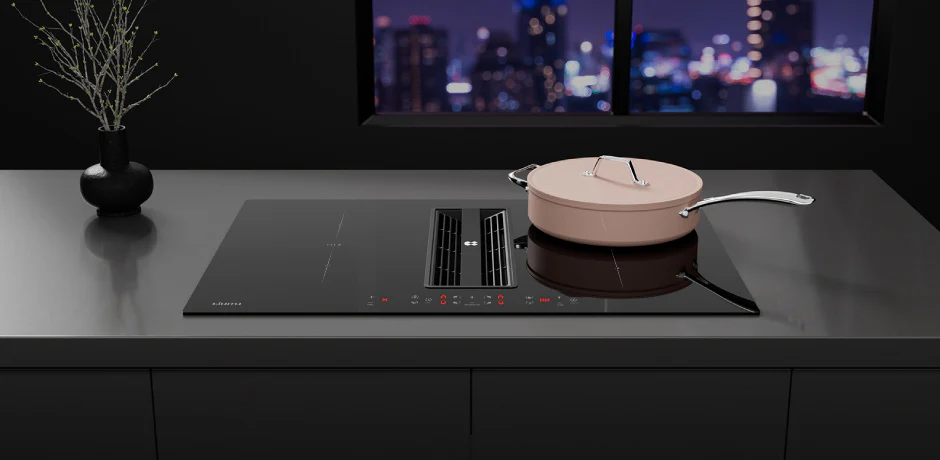A venting hob is a modern kitchen appliance that combines a cooktop with an integrated ventilation system. Unlike traditional extractor hoods, venting hobs remove cooking fumes and odors directly from the source, making them an efficient and stylish solution for kitchen ventilation.

Importance of Venting Hobs in Modern Kitchens
Venting hobs have become essential in modern kitchen design due to their space-saving capabilities and enhanced air quality control. They offer a sleek and discreet alternative to bulky extractor hoods, fitting seamlessly into contemporary kitchen aesthetics.
Types and Categories
Different Types of Venting Hobs
Induction Venting Hobs: Induction venting hobs use electromagnetic fields to heat pots and pans directly, providing precise temperature control and energy efficiency.
Gas Venting Hobs: Gas venting hobs offer the traditional cooking experience with open flames and instant heat adjustment, combined with integrated ventilation.
Electric Venting Hobs: These hobs use electric coils or glass-ceramic surfaces for cooking, with built-in ventilation to manage fumes and smoke.
Technical Specifications
Key Features of Venting Hobs
Power Levels: Venting hobs come with various power settings to suit different cooking needs, from simmering to boiling.
Venting Capacity: The effectiveness of a venting hob is measured by its ability to extract air, typically rated in cubic meters per hour (m³/h).
Noise Levels: Quiet operation is crucial in open-plan kitchens. Venting hobs are designed to minimize noise while maintaining efficient ventilation.
Technical Comparisons
Comparing different models and brands can help you choose the best venting hob for your needs. Look for specifications like power output, venting capacity, and additional features like smart controls.
Applications
Residential Use
Venting hobs are perfect for home kitchens, providing a clean and efficient cooking environment without the need for large extractor hoods.
Commercial Kitchens
In professional settings, venting hobs help maintain air quality and ensure compliance with health and safety standards while offering high-performance cooking.
Benefits
Improved Air Quality
Venting hobs effectively remove smoke, odors, and airborne grease, resulting in a healthier kitchen environment.
Space-Saving Design
By integrating the ventilation system directly into the cooktop, venting hobs free up overhead space and contribute to a more open and streamlined kitchen design.
Energy Efficiency
Many venting hobs, especially induction models, are highly energy-efficient, reducing overall energy consumption in the kitchen.
Enhanced Cooking Experience
With precise temperature control and immediate ventilation, venting hobs enhance the overall cooking experience, making meal preparation more enjoyable and efficient.
Future Prospects
Predicted Technological Advancements
Future developments in venting hobs may include enhanced energy efficiency, more advanced smart features, and improved integration with other kitchen appliances.
Market Trends and Growth
The demand for venting hobs is expected to grow as more consumers seek modern, efficient, and aesthetically pleasing kitchen solutions. Trends indicate a shift towards more sustainable and smart home-compatible appliances.
Comparative Analysis
Venting Hobs vs. Traditional Extractor Hoods
While traditional extractor hoods are effective, venting hobs offer a more integrated and space-saving solution. They eliminate the need for large overhead installations and provide immediate smoke and odor removal.
Comparison with Other Ventilation Solutions
Compared to downdraft extractors and other ventilation systems, venting hobs provide a more seamless and efficient solution, especially in open-plan kitchens where aesthetics are important.
User Guides or Tutorials
Step-by-Step Installation Guide
- Preparation:Ensure proper measurements and clear space for installation.
- Electrical and Ventilation Setup:Follow manufacturer guidelines for electrical connections and ventilation paths.
- Mounting the Hob:Secure the hob in place and connect all necessary components.
- Testing:Verify that the hob and ventilation are working correctly.
Maintenance Tips and Tricks
- Regular Cleaning:Keep the surface and filters clean to ensure optimal performance.
- Filter Replacement:Replace filters as recommended by the manufacturer.
- Check Ventilation Paths:Ensure that ventilation ducts are clear and unobstructed.
Common Troubleshooting
- Ventilation Issues:Check for blockages or incorrect installation.
- Power Problems:Ensure proper electrical connections and check circuit breakers.
- Noise Levels:Verify that the hob is securely mounted and that there are no loose parts.
Conclusion
Venting hobs combine cooking and ventilation into one efficient appliance, offering numerous benefits such as improved air quality, space-saving design, and enhanced cooking experience. While they may come with higher installation and maintenance requirements, their advantages make them a valuable addition to any modern kitchen.

